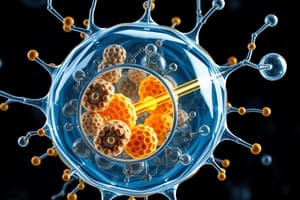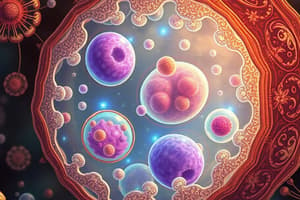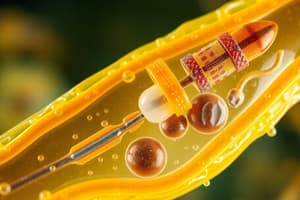Podcast
Questions and Answers
What is the primary function of mitochondria in eukaryotic cells?
What is the primary function of mitochondria in eukaryotic cells?
- Protein synthesis
- Site of respiration (correct)
- Photosynthesis
- Structure and support
Which subatomic particle carries a positive charge?
Which subatomic particle carries a positive charge?
- Proton (correct)
- Electron
- Neutron
- Nucleus
Which transport mechanism requires energy to move substances?
Which transport mechanism requires energy to move substances?
- Facilitated diffusion
- Diffusion
- Osmosis
- Active transport (correct)
In which group of the periodic table are noble gases located?
In which group of the periodic table are noble gases located?
How many electrons can occupy the third shell in an atom?
How many electrons can occupy the third shell in an atom?
Which model of the atom proposed that electrons are embedded in a positive 'soup'?
Which model of the atom proposed that electrons are embedded in a positive 'soup'?
What is the formula for calculating magnification?
What is the formula for calculating magnification?
Which type of energy store is represented by a compressed spring?
Which type of energy store is represented by a compressed spring?
Flashcards
Eukaryotic Cell
Eukaryotic Cell
A cell with a nucleus and other membrane-bound organelles, found in plants and animals.
Diffusion
Diffusion
The passive movement of particles from a high concentration to a low concentration.
Atomic Number
Atomic Number
The number of protons in an atom's nucleus.
Electron Configuration
Electron Configuration
Signup and view all the flashcards
Group 1 Element
Group 1 Element
Signup and view all the flashcards
Kinetic Energy
Kinetic Energy
Signup and view all the flashcards
Active Transport
Active Transport
Signup and view all the flashcards
Magnification Formula
Magnification Formula
Signup and view all the flashcards
Study Notes
Cell Structure and Transport (Biology - B1)
- Eukaryotic Cells: Found in plants and animals. Contain a nucleus, mitochondria, ribosomes, and chloroplasts (plants only). Also have a cell wall (plants only) for structure.
- Prokaryotic Cells: Found in bacteria. Lack a nucleus, small, and simple.
- Diffusion: Passive movement of particles from high to low concentration (e.g., oxygen in, carbon dioxide out).
- Osmosis: Diffusion of water through a semi-permeable membrane. Occurs in plant roots, for example.
- Active Transport: Movement of substances against their concentration gradient, requiring energy (ATP). Example: nutrient absorption in intestines.
- Magnification Formula: Magnification = Image size / Actual size. Important for microscopy.
- Microscopes: Light microscopes have low resolution compared to electron microscopes, which have high resolution.
Atomic Structure (Chemistry - C1)
- Subatomic Particles:
- Protons: Positive (+1), mass of 1.
- Neutrons: Neutral (0), mass of 1.
- Electrons: Negative (-1), negligible mass.
- Atomic Number: Number of protons.
- Mass Number: Number of protons + neutrons.
- Electron Configuration: Electrons occupy energy levels or shells. The first shell holds a maximum of 2 electrons; second and third shells hold a maximum of 8 electrons each.
- Atomic Models:
- Dalton: Solid sphere model.
- Thomson: Plum pudding model (electrons in a positive "soup").
- Rutherford: Nuclear model (positive nucleus, electrons outside).
- Bohr: Electrons in fixed orbits (shells).
The Periodic Table (Chemistry - C2)
- Groups (Columns):
- Group 1: Alkali metals (very reactive, 1 outer electron).
- Group 7: Halogens (reactive non-metals, 7 outer electrons).
- Group 0: Noble gases (inert, full outer shell).
- Periods (Rows): Show increasing atomic number.
- Trends:
- Reactivity increases down Group 1 (easier to lose an electron).
- Reactivity decreases down Group 7 (harder to gain an electron).
Energy (Physics - P1)
- Energy Stores: Thermal, kinetic, gravitational potential, elastic potential, chemical, nuclear, magnetic, electrostatic.
- Energy Transfers:
- Mechanically: Force doing work.
- Electrically: Work done by moving charges.
- By heating: Temperature difference.
- By radiation: Light or sound waves.
- Efficiency Formula: Efficiency = (Useful energy output / Total energy input) × 100.
- Renewable vs Non-renewable Resources:
- Renewable: Solar, wind, hydro, geothermal, tidal.
- Non-renewable: Coal, oil, natural gas, nuclear.
Studying That Suits You
Use AI to generate personalized quizzes and flashcards to suit your learning preferences.




